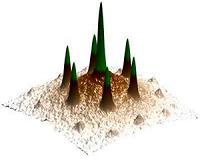 |
Arlington VA (SPX) Apr 22, 2010 Showcasing its energy research initiatives for an Earth Day event on April 22 at the Pentagon, the Office of Naval Research (ONR) will highlight the microbial fuel cell, a device that could revolutionize naval energy use by converting decomposed marine organisms into electricity. These fuel cells convert naturally occurring fuels and oxidants in the marine environment into electricity, offering a clean, efficient and reliable alternative to batteries and other environmentally harmful fuels. The fuel cell can be a viable power source for long-term operation of autonomous underwater unmanned vehicles, in-water sensors, and devices used for surveillance and monitoring the ocean environment. Named as one of TIME magazine's "Top 50 Inventions for 2009," the fuel cell, with its powerful return of clean energy, may reduce carbon emissions in the environment and change the way we fuel our vehicles and supply power to our homes. "Microbial fuel cell research is a great example of naval needs propelling advanced technology that also has potential benefit to the public" said Chief of Naval Research, Rear Adm. Nevin Carr. "The Secretary of the Navy issued five energy goals to the Department of the Navy last October at ONR's Naval Energy Forum and this fuel cell research will help provide part of the solution." "Think of it as a battery that runs on mud," ONR Program Manager Dr. Linda Chrisey said. "They are sustainable, environmentally friendly and don't involve hazardous reactants like a regular battery might because they use the natural carbon in the marine environment. For example, we are working on a 4-foot long autonomous underwater vehicle that will settle on the seafloor and recharge its batteries using this fuel cell approach. We are already able to power many types of sensors using microbial fuel cells." Dr. Leonard Tender, research chemist in the Center for Bio/Molecular Science and Engineering at the Naval Research Laboratory (NRL), has been a central figure in the development of the fuel cell. "We work on the intersection of microbiology and electrochemistry," Tender said. "The most fascinating aspect of the program is how these micro-organisms function and the mechanisms by which they take fuel, metabolize it and generate electrical current." Working with scientists from the University of Massachusetts at Amherst, Tender and his team started to investigate electricity-generating microorganisms. The most promising, called Geobacter, was discovered in the Potomac River immediately downstream of NRL. The discovery of the tiny Geobacter microbe by Dr. Derek Lovley of the University of Massachusetts at Amherst holds the key to understanding microbial energy conversion. Geobacter uses its hair-like extensions, or pili, to generate electricity from mud and wastewater. Researchers have developed a strain of Geobacter that is eight times more efficient than other strains at producing power. "Essentially, they could go on for years without any kind of battery replacement," Chrisey said. For this reason, Navy researchers at the Space and Naval Warfare Systems Center (SPAWAR) Pacific are using fuel cell-powered devices to track Pacific-endangered green sea turtles. "The device is light, efficient and environmentally friendly," said Bart Chadwick, SPAWAR's Head of Environmental Sciences Branch. "The technology is helping track sea turtle populations, if they are feeding near Navy shorefront facilities, which informs Navy decision-making on port operations or construction."
Share This Article With Planet Earth
Related Links Office of Naval Research (ONR) Powering The World in the 21st Century at Energy-Daily.com
 Graphene: What Projections And Humps Can Be Good For
Graphene: What Projections And Humps Can Be Good ForBraunschweig, Germany (SPX) Apr 21, 2010 At present, graphene probably is the most investigated new material system worldwide. Due to its astonishing mechanical, chemical and electronic properties, it promises manifold future applications - for example in microelectronics. The electrons in graphene are particularly movable and could, therefore, replace silicon which is used today as the basic material of fast computer chips. In a ... read more |
|
| The content herein, unless otherwise known to be public domain, are Copyright 1995-2010 - SpaceDaily. AFP and UPI Wire Stories are copyright Agence France-Presse and United Press International. ESA Portal Reports are copyright European Space Agency. All NASA sourced material is public domain. Additional copyrights may apply in whole or part to other bona fide parties. Advertising does not imply endorsement,agreement or approval of any opinions, statements or information provided by SpaceDaily on any Web page published or hosted by SpaceDaily. Privacy Statement |